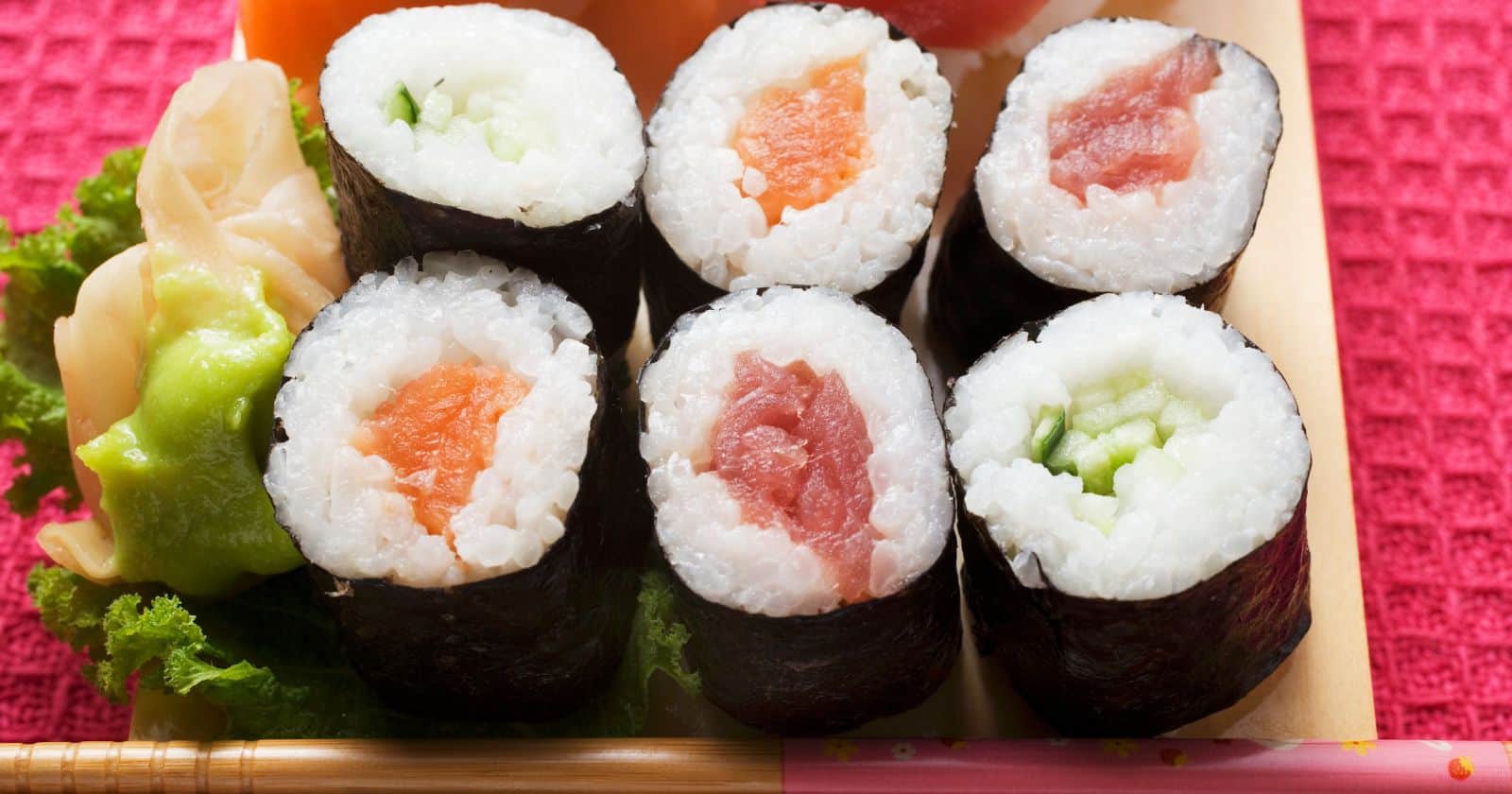What are those colorful rolled up sushi creations called?
Sushi lovers, let’s talk about those irresistible rolled creations you order again and again. You know, the ones stuffed with fish, rice, veggies or cream cheese, sliced diagonal and served alongside your miso soup. These tasty morsels have a specific name – they’re called maki sushi rolls!
Maki rolls, also known as norimaki, are a traditional Japanese sushi featuring seasoned rice and various fillings rolled up in sheets of seaweed or nori. Here’s a quick rundown of maki roll varieties:
- Hosomaki – skinny mini rolls with just one filling
- Futomaki – fatter rolls with multiple ingredients
- Uramaki – inside-out rolls with rice on the outside
Popular maki fillings include salmon, yellowtail, tuna, crabmeat, cucumber, and avocado. And don’t forget sauce – a brush of soy sauce, spicy mayo or eel sauce makes maki even more craveable!
Now that you’re a maki master, let’s dig into the delicious world of sushi rolls. Read on for pro tips, recipes and creative maki roll inspiration!
What is Maki Sushi?
Maki sushi (also called norimaki) refers to rolls made with rice and various fillings wrapped in sheets of nori seaweed. The term “maki” means “to roll” in Japanese.
The key components of maki rolls are:
- Sushi rice – White, short-grain, seasoned rice.
- Nori – Dried, roasted seaweed cut into sheets.
- Fillings – Raw or cooked fish, vegetables, eggs, etc.
- Condiments – Soy sauce, wasabi, pickled ginger.
Maki rolls come in different sizes and styles, but they all contain those basic elements. Now let’s break down the most common maki roll varieties.
Types of Maki Rolls
There are a few main categories of maki sushi rolls:
Hosomaki – Skinny Rolls
Hosomaki, meaning “thin rolls,” are about 1 inch thick and contain just one filling ingredient along with rice and nori. Some classic hosomaki fillings are:
- Cucumber roll (Kappamaki)
- Tuna roll (Tekkamaki)
- Salmon roll (Sakemaki)
Due to their petite size, hosomaki are a great starter sushi.
Futomaki – Fat Rolls
Futomaki rolls are thicker, around 2-3 inches wide, and stuffed with multiple fillings. Futomaki means “fat rolls” in Japanese. Some examples are:
- California roll – Crabmeat, avocado, cucumber
- Dynamite roll – Shrimp tempura, veggies
- Spicy tuna roll – Spicy tuna, cucumber
The diverse ingredients make futomaki rolls tasty and substantial.
Uramaki – Inside-Out Rolls
Uramaki sushi rolls have the rice on the outside and nori on the inside. Popular uramaki examples include:
- Philadelphia roll – Smoked salmon, cream cheese
- Rainbow roll – Fish, avocado, multi-colored toppings
- Caterpillar roll – Eel, avocado, etc.
Uramaki allow for creative presentations with colorful fish and toppings layered on the outside.
How to Assemble Maki Rolls
Making perfect maki rolls takes skill, but here is a basic overview:
- Place a nori sheet shiny-side down on a bamboo rolling mat.
- Spread seasoned sushi rice evenly over the nori, leaving 1/4 inch bare at the end.
- Line up desired fillings across the middle of the rice.
- Lift edge of mat over to encase fillings and roll away from you in one smooth motion to seal the roll.
- Gently shape the roll through the mat to compress it.
- Slice the roll into rounds using a sharp, wet knife.
It takes practice to master the rolling technique, but it’s very satisfying when those beautiful maki rolls come out picture-perfect!
Filling Ideas for Delicious Maki
Almost anything can go into a maki roll, giving you endless options for creativity. Try these tasty fillings:
Fish Favorites
- Tuna – Yellowfin or albacore, often seared or marinated
- Salmon – Silky raw or smoked salmon
- Shrimp – Cooked, marinated or tempura shrimp
- Crab – Real or imitation crabstick
- Eel – Broiled unagi eel
- Ikura – Briny salmon roe
Veggie Delights
- Cucumber – Cool, crunchy classic
- Avocado – Rich, creamy
- Asparagus – Earthy, sweet
- Bell peppers – For color and crunch
- Spinach – Quick-wilted or raw
- Pickled daikon – Bright, tart
Creative Extras
- Tamago – Sweet Japanese omelet
- Tempura – Crispy shrimp or veggies
- Cream cheese – For richness
- Mango – Juicy, tropical twist
- Fried onion – For crunch and zing
Get inspired mixing and matching any ingredients that strike your fancy!
Sauces and Condiments
Don’t forget the finishing touches that make maki rolls pop:
- Soy sauce – For salty flavor, use sparingly.
- Wasabi – Spicy Japanese horseradish, often mixed into soy sauce for dipping.
- Pickled ginger – Palate cleanser with sushi, slices pickled in sweet vinegar.
- Sriracha mayo – Spicy creamy blend, often drizzled over rolls.
- Eel sauce – Sweet brown sauce for rolls with eel.
- Ponzu – Citrusy soy dipping sauce.
These sauces accent the fresh maki ingredients perfectly.
Maki Sushi Etiquette
To enjoy maki like a pro:
- Use chopsticks to pick up rolls, or fingers for hand rolls. Don’t stick sushi rice-side down into soy sauce.
- Take a small bite so fillings don’t fall out.
- Savor each piece before moving onto the next.
- Wasabi is spicy, so use a little at a time.
- Ginger acts as a palate cleanser between different rolls.
Now that you’re armed with all the maki roll fundamentals, you can confidently order and enjoy these Japanese restaurant staples. Impress your friends with your newfound knowledge of sushi tradition.
Maki sushi offers endless variations to explore. Why not try rolling your own maki creations at home? Load up that sushi mat and get rolling for fresh, homemade sushi anyone would love.





